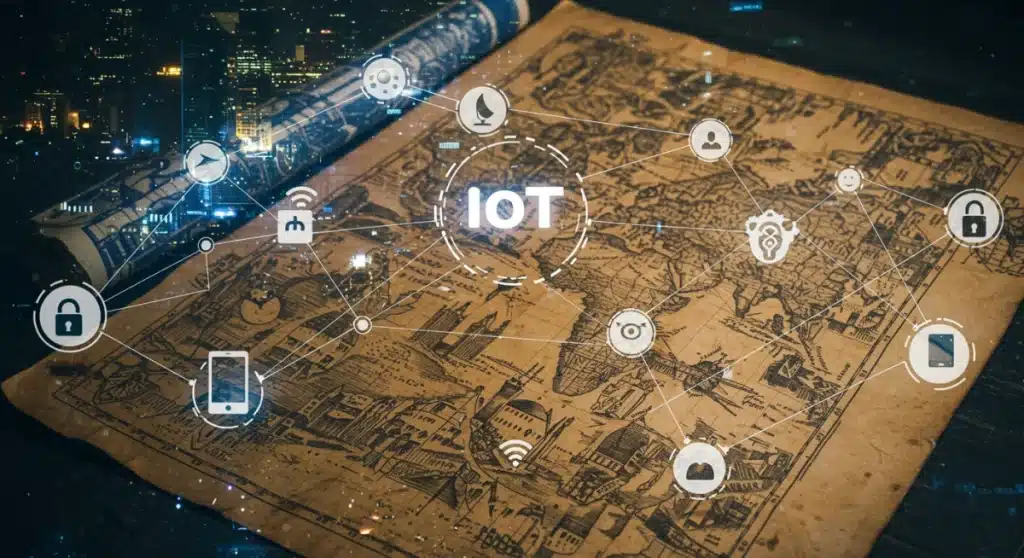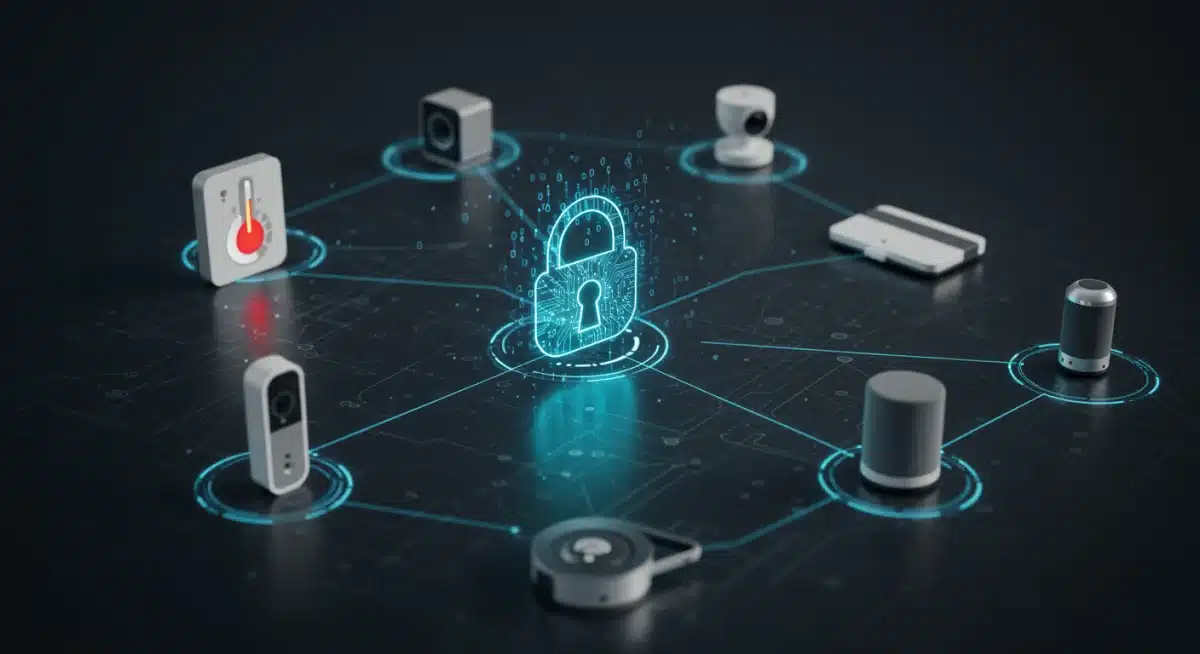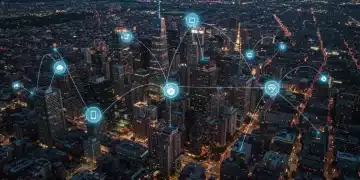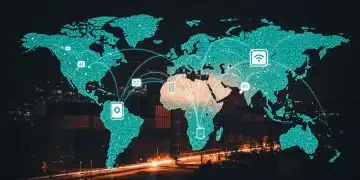IoT Genesis: Historical Parallels & 2025 Security Implications

The ongoing evolution of the Internet of Things (IoT) presents significant security implications for 2025, drawing critical historical parallels to past technological advancements and demanding practical, proactive solutions to safeguard interconnected systems.
The rapid expansion of the Internet of Things (IoT) is not merely a modern phenomenon; it echoes historical technological shifts that reshaped societies. Understanding The Genesis of the Internet of Things: Historical Parallels and 2025 Security Implications (PRACTICAL SOLUTIONS) is crucial as we approach a future where billions of interconnected devices demand robust security frameworks. What lessons can we draw from the past to secure our increasingly smart world?
The Dawn of Connectivity: Precursors to Modern IoT
Before the term “Internet of Things” was coined, the concept of interconnected, intelligent devices was already taking shape. Early innovations laid the groundwork for today’s ubiquitous smart technology, demonstrating a long-standing human desire to automate and optimize processes through connectivity.
From the first networked toasters to early industrial control systems, the drive to connect disparate elements for enhanced functionality has been a consistent theme in technological progression. These initial steps, often rudimentary by today’s standards, were vital proof-of-concepts.
Early Networked Devices
The idea of devices communicating without human intervention can be traced back decades. Pioneering efforts in telemetry and remote monitoring were early indicators of IoT’s potential. These systems, while specialized, showcased the power of data exchange.
- ATMs (1960s): Early networked machines for financial transactions.
- SCADA Systems (1970s): Industrial control systems for remote monitoring and control.
- Packet Radio Networks (1970s): Experimental networks for data communication.
- Coca-Cola Machine (1982): First internet-connected appliance, reporting its inventory.
These historical examples highlight that the fundamental principles of IoT—sensing, communicating, and acting—are not new. What has changed dramatically is the scale, accessibility, and complexity of these interconnections.
Historical Parallels: Lessons from Past Technological Revolutions
Examining past technological revolutions offers invaluable insights into the challenges and opportunities presented by the current IoT boom. Each era of significant innovation, from the industrial revolution to the advent of the personal computer and the internet, brought its own set of unforeseen consequences, particularly in security and societal impact.
The rapid adoption of new technologies often outpaces the development of adequate safeguards, creating vulnerabilities that are exploited later. Learning from these patterns is essential for proactively addressing the security implications of IoT.
The Telegraph and Early Network Security
The telegraph, a revolutionary communication technology of the 19th century, faced its own security challenges. Messages could be intercepted, and lines could be cut, leading to early forms of cryptographic efforts and physical security measures for infrastructure.
- Message Interception: Early systems were vulnerable to eavesdropping.
- Infrastructure Vulnerability: Physical lines were susceptible to sabotage.
- Early Encryption: Codes and ciphers were developed to protect sensitive communications.
Similarly, the internet’s early days were marked by a focus on functionality over security, leading to widespread vulnerabilities that continue to plague systems today. This historical oversight serves as a potent reminder for the current trajectory of IoT.
The lessons from past revolutions underscore the need for integrated security from the design phase, rather than as an afterthought. Failing to do so can lead to systemic weaknesses that are difficult and costly to rectify post-deployment.
The Rise of IoT and Its Current Security Landscape
Today’s IoT landscape is characterized by an explosion of diverse devices, from smart home gadgets to industrial sensors and connected vehicles. This proliferation creates an expansive attack surface, making security a paramount concern. The sheer volume and variety of devices complicate traditional security approaches.
Many IoT devices are designed for cost-effectiveness and ease of use, often at the expense of robust security features. This inherent vulnerability, coupled with inadequate patching and update mechanisms, creates fertile ground for cyber threats.
Common IoT Vulnerabilities
Several recurring weak points define the current IoT security posture. These vulnerabilities are often exploited by attackers to gain unauthorized access, launch denial-of-service attacks, or compromise data integrity.
- Weak Default Passwords: Many devices ship with easily guessable or hardcoded credentials.
- Lack of Encryption: Data transmitted by some devices is unencrypted, allowing eavesdropping.
- Unpatched Firmware: Manufacturers often fail to provide timely security updates, leaving devices exposed.
- Insecure Network Services: Open ports and unnecessary services increase attack vectors.
The fragmented nature of the IoT ecosystem, with numerous manufacturers and varying security standards, exacerbates these issues. Consumers and businesses often lack the expertise or resources to properly secure their devices, further widening the security gap.
Projected Security Implications for IoT in 2025
Looking ahead to 2025, the security implications for IoT are set to intensify significantly. As more critical infrastructure, healthcare systems, and personal lives become reliant on interconnected devices, the potential for widespread disruption and harm increases dramatically. Nations and corporations are already bracing for advanced persistent threats targeting these systems.
The convergence of 5G networks, artificial intelligence, and edge computing will introduce new layers of complexity and new attack vectors. This evolution demands a proactive and adaptive approach to cybersecurity.
Emerging Threats and Challenges
The threat landscape is continuously evolving, with attackers becoming more sophisticated. By 2025, we anticipate several key areas of concern:
- AI-Powered Attacks: Malicious AI can learn and adapt to exploit IoT vulnerabilities at scale.
- Supply Chain Attacks: Compromises introduced during manufacturing or distribution.
- Ransomware on Critical Infrastructure: Targeting smart grids, water systems, and transportation networks.
- Data Privacy Breaches: Exploitation of sensitive personal and operational data collected by IoT devices.
The interconnectedness means that a breach in one seemingly minor device could serve as a gateway to broader, more critical systems. This ripple effect makes comprehensive security strategies indispensable.
Furthermore, the legal and regulatory frameworks are struggling to keep pace with technological advancements, creating uncertainty about accountability and liability in the event of major IoT security incidents.
Practical Solutions for Securing IoT by 2025
Addressing the escalating security challenges of IoT by 2025 requires a multi-faceted approach, integrating technological advancements with policy changes and user education. Practical solutions must span the entire lifecycle of IoT devices and systems, from design to deployment and ongoing maintenance.
Proactive measures and collaborative efforts between manufacturers, governments, and end-users are essential to build a resilient and secure IoT ecosystem. The goal is to embed security as a foundational element, not an optional add-on.
Key Security Strategies
Several actionable strategies can significantly enhance IoT security. These approaches focus on reducing vulnerabilities and improving incident response capabilities.
- Secure by Design: Integrating security features from the initial stages of device development.
- Regular Firmware Updates: Implementing robust mechanisms for over-the-air (OTA) updates and patches.
- Strong Authentication: Mandating multi-factor authentication and unique, complex passwords.
- Network Segmentation: Isolating IoT devices on separate network segments to contain breaches.
- AI-Driven Anomaly Detection: Utilizing AI to identify unusual behavior on IoT networks.
Beyond technology, user education is critical. Many breaches occur due to human error, such as using default passwords or connecting devices to unsecured networks. Awareness campaigns and clear guidelines for secure IoT usage can empower users.
The adoption of industry-wide security standards and certifications can also help elevate the baseline security posture of IoT devices, providing consumers with greater assurance of product reliability and safety.

Regulatory Frameworks and International Cooperation
The global nature of IoT necessitates international cooperation and harmonized regulatory frameworks to effectively manage security risks. Patchwork regulations can create loopholes and hinder the widespread adoption of secure practices. Governments and international bodies are increasingly recognizing this need.
Establishing common standards and legal obligations for IoT device manufacturers and service providers is crucial. This ensures a consistent level of security across different regions and product types, fostering trust in the technology.
Global Initiatives and Policy Development
Several organizations are working towards developing comprehensive IoT security policies and guidelines. These efforts aim to provide a roadmap for securing the interconnected world.
- ENISA (European Union Agency for Cybersecurity): Developing baselines for IoT security.
- NIST (National Institute of Standards and Technology): Publishing guidelines and recommendations for IoT cybersecurity.
- IoT Security Foundation (IoTSF): Promoting best practices and industry collaboration.
These initiatives often focus on areas such as data protection, vulnerability disclosure, and secure development lifecycle. The goal is to create an environment where security is not just a feature but a fundamental characteristic of all IoT deployments.
Furthermore, international agreements on data sharing and cybercrime prevention are vital for prosecuting malicious actors and preventing cross-border attacks. The collective effort is necessary to build a truly resilient global IoT infrastructure.
| Key Aspect | Brief Description |
|---|---|
| Historical Parallels | Past tech revolutions (telegraph, internet) show security often lags innovation, leading to vulnerabilities. |
| 2025 Threat Landscape | Expect AI-powered attacks, supply chain compromises, and ransomware targeting critical infrastructure. |
| Practical Solutions | Secure by design, regular updates, strong authentication, network segmentation, and AI anomaly detection. |
| Regulatory Needs | Harmonized global standards and international cooperation are crucial for effective IoT security governance. |
Frequently Asked Questions About IoT Security
By 2025, the primary security challenge for IoT will be managing the immense and fragmented attack surface created by billions of diverse devices. This complexity, combined with advanced threats like AI-powered attacks and supply chain compromises, makes comprehensive protection difficult to achieve without integrated strategies.
Historical shifts, such as the telegraph and early internet, reveal a recurring pattern where innovation outpaces security development. This often leads to widespread vulnerabilities. Understanding these parallels emphasizes the critical need for proactive, integrated security measures in IoT design and deployment to avoid repeating past mistakes.
Individuals can enhance IoT security by changing default passwords, enabling multi-factor authentication, regularly updating device firmware, and segmenting their home networks. Disabling unnecessary features and being cautious about connecting devices to public Wi-Fi also significantly reduce personal risk against cyber threats.
International cooperation is vital because IoT is a global phenomenon. Disparate national regulations create security gaps. Harmonized standards and shared intelligence among countries help establish a consistent baseline for device security, facilitate rapid threat response, and enable effective prosecution of cyber criminals across borders.
By 2025, AI will be a double-edged sword for IoT security. Malicious AI can orchestrate sophisticated, adaptive attacks on IoT networks. Conversely, AI is also crucial for defense, enabling real-time anomaly detection, predictive threat analysis, and automated responses to protect vast, complex IoT ecosystems more effectively.
Looking Ahead
The trajectory of the Internet of Things indicates an ever-increasing integration into daily life and critical infrastructure. The security implications for 2025 are not merely theoretical; they represent immediate and tangible threats that require concerted action. As the world becomes more interconnected, the lessons from history underscore the urgency of prioritizing robust security measures. The coming years will define whether humanity successfully harnesses the power of IoT securely, or succumbs to its inherent vulnerabilities. Industry leaders, policymakers, and individual users must collaborate to build a resilient digital future.





